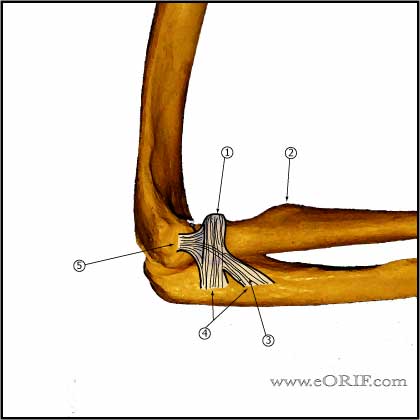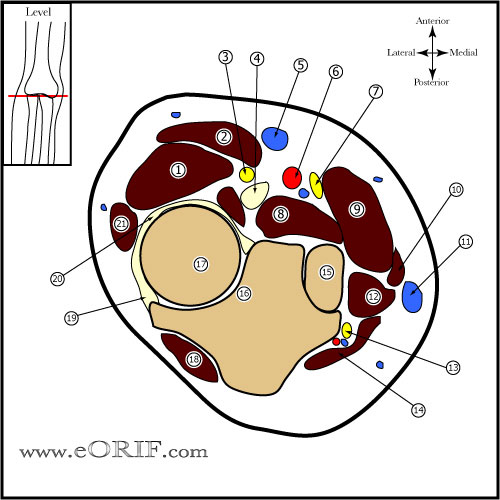|



|
synonyms: PLRI, posterolateral rotatory instability
Posterolateral Rotatory Instability ICD-10
Posterolateral Rotatory Instability ICD-9
- 718.93 (unspecified derangement of joint; forearm)
- 718.33 (recurrent dislocation of joint; forearm)
Posterolateral Rotatory Instability Etiology / Epidemiology / Natural History
- Occurs during a valgus moment to the elbow wtih simultaneous forearm supination.
- LUCLis disrupted or improperly healed.
- May occur after failed lateral epicondyle debridement (tennis elbow).
- Other causes: repeated corticosteriod injection. (Kalainov DV, JBJS 2005;87Am:11120), late effect of cubitus varus from supracondylar humeral malunion, congenital hypoplasia of the medial coronoid, chronic overoad such as in prolonged crutch use, connective tissue disease.
Posterolateral Rotatory Instability Anatomy
- Primary restraint to posterolateral rotatory instability of the elbow is the combination of the lateral collateral and annular ligaments. The principal secondary restraints are the extensor muscles with their fascial bands and intermuscular septa. (Cohen MS, JBJS 1997;79A:225), (McAdams TR, JSES, 2005;14:298).
- Contributors to PLRI: lax lateral ulnar collateral ligament, lax radial collateral ligament, lax annular ligament, chornic cubitus varus, radial head excision.
- See also Elbow anatomy.
Posterolateral Rotatory Instability Clinical Evaluation
- Complains of recurrent painful clicking, popping, snapping or locking of the elbow. Symptoms mainly noted during extension with forearm in suppination.
- Posterolateral rotatory apprehension test: elbow is supinated with mild force at wrist and a valgus moment is applied to elbow during a flexion movment. The pt feels apprehension and reproduction of symptoms. If under anesthesia can feel subluxation/reduction.
- Lateral pivot-shift test:
- Posterolateral rotatory drawer test:
- Chair test:
- Push-up sign
- Consider exam under anesthesia with fluoroscopy in questionable cases.
Posterolateral Rotatory Instability Xray / Diagnositc Tests
Posterolateral Rotatory Instability Classification / Treatment
- (O'Driscoll SW, CORR 1992;280:195).
- Stage 1: disruption of the LUCL productin joint subluxation.
- Stage 2: disruption of the anterior and posterior capsules. Coronoid is "perched" under the trochlea.
- Stage 3A: all soft tissue is disrupted except for the anterior band of the MCL.
- Stage 3B: rupture fo the anterior band of the MCL. Elbow is unstable to valgus force. Elbow just be kept on 30° to 45° of flexion to maintain reduction.
- Stage 3C: entire distal humerus is stripped of soft tissue, elbow is grossly unstable. Joint is only stable at >90° of flexion.
- Treatment = PLRI Reconstruction Technique vs Direct repair (Sanchez-Sotelo J, JBJS 2005;87Br:54).
Posterolateral Rotatory Instability Associated Injuries / Differential Diagnosis
- Varus posteromedial rotatory dislocation / instablity (occurs during axial loading of elbow in flexion=anteromedial coronoid fractureand avulsion of LCL).
- Coronoid fracture
- Terrible triad (elbow dislocation with radial head and coronoid fracture)
- Olecranon fracture
- Elbow Dislocation
- Radial head fracture
- Valgus Instability
- Distal humerus fracture
- Monteggia fracture
- Medial Epicondyle fracture
Posterolateral Rotatory Instability Complications
- Infection
- Bony bridge fracture
- Cutaneous nerve injury
- Stiffness / Arthrofibrosis / flexion contracture
- Instability
Posterolateral Rotatory Instability Follow-up Care
- Post-op: Elbow is immobilized with a posterior splint with elbow in pronation.
- 7-10 Days: Place in hinged elbow brace with forearm in pronation.
- 6 Weeks: Pt may removed hinged brace for sedentary activities.
- 3 Months: Progress with strengthening and ROM exercises. Sport specific rehab.
- 6 Months: May return to sport.
Posterolateral Rotatory Instability Review References
- OKU - Shoulder and Elbow 2nd ed, 2002
- Mehta JA, JAAOS 2004;12:405
- Advanced Reconstruction-Elbow, AAOS 2007
|



